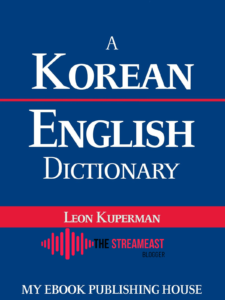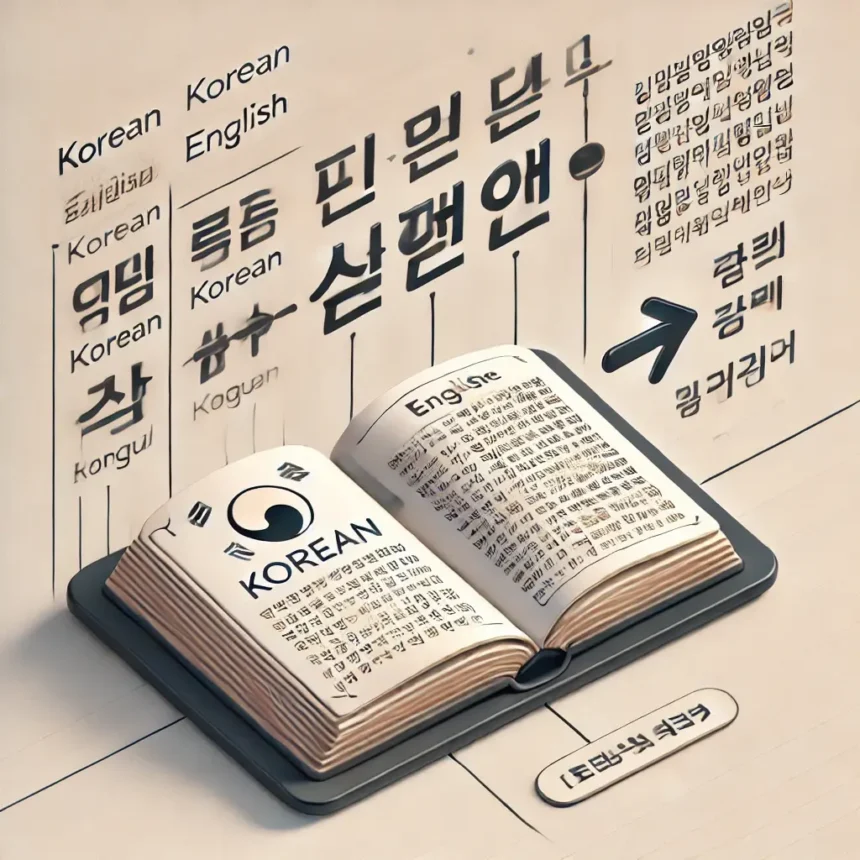Introduction: Korean to English
The demand for Korean to English Translation has grown significantly. With the rise of Korean culture, including K-pop, K-dramas, and Korean literature, the need for accurate translations is more important than ever. Whether you are a professional translator, a student, or someone interested in the Korean language, understanding how to translate Korean to English can open many doors.
Why Korean to English Translation is Important
Translating Korean to English is crucial for several reasons. It helps in bridging cultural gaps, allowing people from different backgrounds to understand and appreciate Korean content. Businesses rely on accurate translations to communicate effectively with global audiences. Moreover, it enables the sharing of knowledge, literature, and entertainment across the world.
Understanding the importance of Korean-to-English translation is the first step in mastering this skill.
Key Differences Between Korean and English
Korean and English are vastly different languages. These differences could be clearer when translating Korean to English.
Grammar Structure
Korean follows a Subject-Object-Verb (SOV) structure, while English uses a Subject-Verb-Object (SVO) structure. For example:
- Korean: “나는 사과를 먹는다.” (I apple eat.)
- English: “I eat an apple.”
This difference in sentence structure is one of the biggest challenges when translating Korean to English.
Honorifics
Koreans use honorifics to show respect. The level of respect depends on the relationship between the speaker and the listener. In English, this concept exists in different ways, making it difficult to translate honorifics from Korean to English accurately.
Vocabulary
Korean vocabulary includes many words that do not have direct English equivalents. This requires the translator to find the closest possible meaning or rephrase the sentence. Understanding cultural nuances is essential for an accurate Korean-to-English translation.
Pronouns and Context
Koreans often omit pronouns because the subject is understood from context. In English, pronouns are necessary for clarity. Translators need to ensure that the meaning is clear when converting Korean to English.
Strategies for Effective Korean-to-English Translation
Translating Korean to English requires specific strategies to overcome language differences. Here are some tips for effective translation:
Understand the Context
Context is crucial when translating Korean to English. A word or phrase may have different meanings depending on the situation. Understanding the context helps ensure that the translation is accurate and conveys the intended message.
Focus on Meaning, Not Just Words
Word-for-word translation rarely works when converting Korean to English. Focus on translating the meaning of the sentence rather than just the words. This approach helps maintain the integrity of the original text.
Learn Common Idioms and Expressions
Korean and English have unique idioms and expressions. Understanding these can help you translate them more accurately. For example:
- Korean: “바람을 맞다” (To be stood up)
- English: “To be left hanging”
Knowing these common expressions makes translating Korean to English smoother and more natural.
Use Technology Wisely
Translation tools and apps can be helpful when translating Korean to English. However, they should be used with caution. These tools may only sometimes capture the nuances of the language, so it’s important to review and refine the translation.
Practice Regularly
Regular practice is key to improving your Korean-to-English translation skills. Translate different types of texts, such as news articles, short stories, and dialogues. The more you practice, the better you will become at handling complex translations.
Common Challenges in Korean-to-English Translation
Translating Korean to English has its challenges. Here are some common issues you may encounter:
Ambiguity in Pronouns
As mentioned earlier, Koreans often omit pronouns, relying on context. This can create ambiguity when translating Korean to English. It’s important to clarify the subject when translating to make sure everything is clear.
Cultural References
Korean culture is rich and unique. Cultural references, such as historical events, traditional customs, and local idioms, can be difficult to translate into Englishss. The translator must understand the cultural context to provide an accurate translation.
Handling Politeness Levels
Korean language has different levels of politeness, depending on the speaker’s relationship with the listener. Englishs does not have a direct equivalent for these levels, which can make translating Korean to Englishs challenging. The translator must choose the appropriate level of formality to match the original text.
Differences in Humor
Humor is another challenge when translating Korean to Englishs. Jokes and puns often rely on wordplay and cultural context, which may translate poorly. Translators need to find creative ways to convey the humor in Englishs.
Technical Terminology
In technical fields like medicine, law, and engineering, specific terminology can be difficult to translate from Korean to Englishs. It’s important to have a good understanding of the subject matter and use appropriate technical terms in the translation.
Tools and Resources for Korean-to-English Translation
There are several tools and resources available to help with Korean-to-Englishs translation. Here are some of the most useful ones:
Online Dictionaries
Online dictionaries are essential for translating Korean to Englishs. They provide definitions, synonyms, and example sentences. Some popular online dictionaries include the Naver Dictionary and the Daum Dictionary.
Translation Apps
Translation apps, such as Google Translate, Papago, and iTranslate, can be useful for quick translations. However, they are not always accurate, so it’s important to double-check the translation.
Language Learning Platforms
Language learning platforms, like Duolingo and Memrise, can help you improve your Korean language skills. These platforms offer exercises and quizzes that can enhance your understanding of Korean grammar and vocabulary, making Korean-to-Englishs translation easier.
Translation Forums and Communities
Joining translation forums and online communities can be helpful. These platforms allow you to ask questions, share experiences, and learn from other translators. Websites like ProZ and TranslatorsCafe are great places to connect with fellow translators.
Korean-English Translation Books
There are many books available that focus on translation from Korean to Englishs. These books provide in-depth explanations of grammar, vocabulary, and translation techniques. Investing in a good translation book can be beneficial for both beginners and advanced translators.
The Role of Machine Translation in Korean to English
Machine translation has made significant advancements, but it still faces challenges, especially with Korean-to-Englishs translation. While machine translation tools like Google Translate and DeepL can be useful, they often need help with the nuances and complexities of the Korean language.
Advantages of Machine Translation
Machine translation tools are fast and convenient. They are useful for getting a general understanding of a text or for translating simple sentences. These tools are also constantly improving, thanks to advances in artificial intelligence and machine learning.
Limitations of Machine Translation
Despite their advantages, machine translation tools have limitations. They may not accurately translate idiomatic expressions, cultural references, or complex sentence structures. As a result, the output may require significant editing to ensure accuracy when translating Korean to Englishs.
Combining Machine Translation with Human Input
The best approach is to use machine translation as a starting point and then refine the translation with human input. Human translators can correct errors, adjust the tone, and ensure that the translation captures the original meaning.
Tips for Learning Korean for English Speakers
Learning Korean as an Englishs speaker can enhance your ability to translate Korean to Englishs. Here are some tips for learning Korean:
Start with the Basics
Begin by learning the Korean alphabet, Hangul. Hangul is logical and easy to learn, making it a great starting point for beginners. Once you understand Hangul, you can start learning basic vocabulary and grammar.
Immerse Yourself in the Language
Immerse yourself in the Korean language by listening to Korean music, watching Korean dramas, and reading Korean books. Immersion helps you become familiar with the sounds, rhythms, and patterns of the language, which is essential for effective translation.
Practice Speaking and Listening
Speaking and listening are important skills for translation. Practice speaking Korean with native speakers or language partners. Listening to Korean podcasts or news broadcasts can also help you improve your listening skills.
Use Flashcards for Vocabulary
Flashcards are a great way to build your Korean vocabulary. Create flashcards with Korean words on one side and their English translations on the other. Reviewing flashcards can help reinforce your memory and improve your ability to translate Korean to Englishs.
Take a Language Course
Consider enrolling in a Korean language course. Many universities, language schools, and online platforms offer Korean courses for different skill levels. A structured course can provide you with the grammar and vocabulary foundation needed for translation.
The Future of Korean-to-English Translation
The future of Korean-to-Englishs translation looks promising. With the continued growth of Korean culture worldwide, the demand for accurate and culturally sensitive translations will likely increase. Advances in technology, including machine translation and AI, will continue to improve, but human translators will remain essential for high-quality translations.
Cultural Exchange and Globalization
As the world becomes more interconnected, the exchange of ideas, culture, and information between Korea and Englishs-speaking countries will continue to grow. This cultural exchange will drive the need for skilled translators who can bridge the language gap.
Technological Advancements
Technology will play a significant role in the future of Korean-to-Englishs translation. Machine learning and AI will become more sophisticated, enabling faster and more accurate translations. However, human translators will still be needed to ensure that translations are culturally appropriate and contextually correct.
Growing Demand for Specialized Translation
The demand for specialized translation services in fields like business, law, medicine, and entertainment will continue to grow. Translators with expertise in these areas will be in high demand. Developing specialized knowledge in a particular field can give translators a competitive edge.

FAQs About Korean to English Translation
Q: What is the best way for English speakers to learn Korean?
A: The best way to learn Korean is to start with the basics, such as the Hangul alphabet, and gradually build your vocabulary and grammar knowledge. Immersion, practice, and taking language courses can also help you learn effectively.
Q: Can I rely on machine translation for Korean to English translation?
A: Machine translation can be helpful for simple translations, but it may not accurately capture the nuances of the Korean language. It’s best to use machine translation as a starting point and refine the translation with human input.
Q: How can I improve my Korean-to-English translation skills?
A: Practice regularly, focus on understanding the context, and learn common idioms and expressions. Using online resources, language learning platforms, and translation forums can also help improve your skills.
Q: What are the common challenges in Korean to English-translation?
A: Common challenges include differences in grammar structure, handling pronouns, translating cultural references, and dealing with honorifics. Understanding these challenges can help you prepare for them and improve your translation accuracy.
Q: Is it necessary to understand Korean culture to translate accurately?
A: Yes, understanding Korean culture is essential for accurate translation. Cultural references, idioms, and honorifics are deeply rooted in Korean culture, and understanding them is crucial for conveying the correct meaning in English.
Q: What tools can help with Korean-to-English translation?
A: Online dictionaries, translation apps, language learning platforms, and translation books are useful tools. Combining these resources with regular practice can help you become a better translator.
Conclusion
is both challenging and rewarding. It requires a deep understanding of both languages, an appreciation of cultural nuances, and the ability to convey meaning accurately. While technology plays a role in assisting translations, human translators are essential for delivering high-quality, culturally sensitive translations. As the global influence of Korean culture continues to grow, the demand for skilled translators will only increase. By following the tips and strategies outlined in this article, you can improve your Korean-to-Englishs translation skills and contribute to the sharing of Korean culture with the world.





